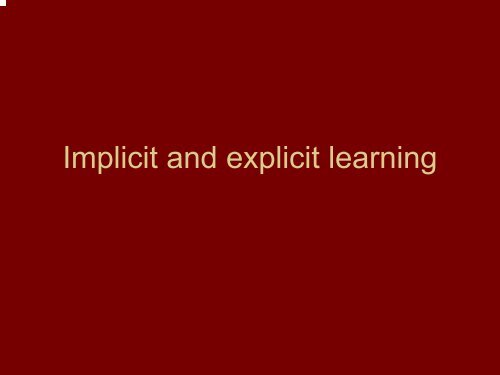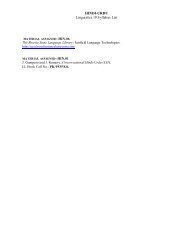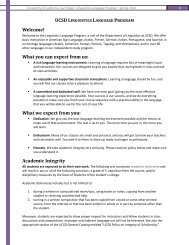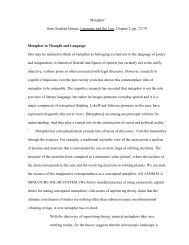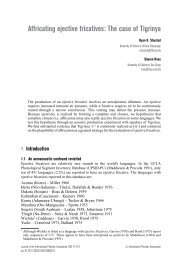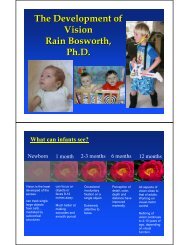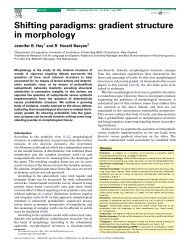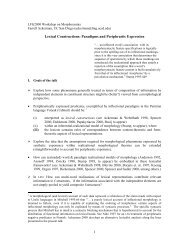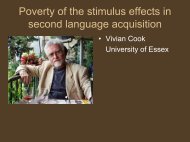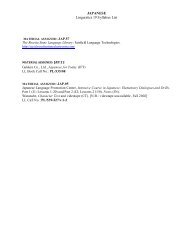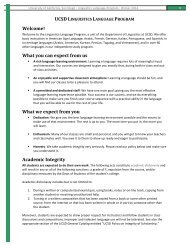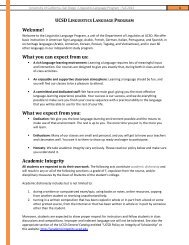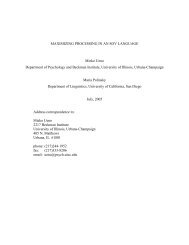Implicit and explicit learning
Implicit and explicit learning
Implicit and explicit learning
You also want an ePaper? Increase the reach of your titles
YUMPU automatically turns print PDFs into web optimized ePapers that Google loves.
<strong>Implicit</strong> <strong>and</strong> <strong>explicit</strong> <strong>learning</strong>
Does <strong>explicit</strong> <strong>learning</strong> lead toimplicit knowledge?• This is what Ellis tries to answer.• His strategy:– Look at instruction that encourages <strong>explicit</strong>knowledge.– See if it improves implicit knowledge.
But implicit knowledge is hard totest• How do you know whether it is there?• Usual way to tell: free production• Compare learners who have had theinstruction with those who have not, <strong>and</strong>see how they do on free production.
Reasons why you would not expect<strong>explicit</strong> <strong>learning</strong> to become implicit• Explicit rules may be completely unlikeneeded implicit rules.• Not clear that enough examples can begiven in a lesson/unit to allow implicitknowledge to develop.• Examples used for <strong>explicit</strong> <strong>learning</strong> maydistort input, mislead learners, delayacquisition, etc.
Reasons why you would not expect<strong>explicit</strong> <strong>learning</strong> to become implicit• Explicit rules may be completely unlikeneeded implicit rules.• Not clear that enough examples can begiven in a lesson/unit to allow implicitknowledge to develop.• Examples used for <strong>explicit</strong> <strong>learning</strong> maydistort input, mislead learners, delayacquisition, etc.
Explicit rules may be completelyunlike needed implicit rules• We can <strong>explicit</strong>ly present a grammar pointin a certain way, but how do we know thatthe brain deals with it this same wayimplicitly?• Example: He is → he’s
Reasons why you would not expect<strong>explicit</strong> <strong>learning</strong> to become implicit• Explicit rules may be completely unlikeneeded implicit rules.• Not clear that enough examples can begiven in a lesson/unit to allow implicitknowledge to develop.• Examples used for <strong>explicit</strong> <strong>learning</strong> maydistort input, mislead learners, delayacquisition, etc.
Not clear that enough examplescan be given in a lesson/unit toallow implicit knowledge to develop• How much exposure is needed forirregular verbs in English (<strong>and</strong> theirfamilies!) to develop?• A lot!
Reasons why you would not expect<strong>explicit</strong> <strong>learning</strong> to become implicit• Explicit rules may be completely unlikeneeded implicit rules.• Not clear that enough examples can begiven in a lesson/unit to allow implicitknowledge to develop.• Examples used for <strong>explicit</strong> <strong>learning</strong> maydistort input, mislead learners, delayacquisition, etc.
Examples used for <strong>explicit</strong> <strong>learning</strong>may distort input, mislead learners,delay acquisition, etc.• In other words, we should always followthe rule …
First, do no harm.• We don’t want to do anything that willharm the learner’s implicit <strong>learning</strong>.• But could classroom activities actually doharm?• Some of them probably do.
How could a grammatical activitydo harm?!?• Imagine an activity that encouragesstudents to focus on a misleadinggeneralization.• Such an activity could encourage thestudents’ implicit <strong>learning</strong> to go down thewrong path.• Unfortunately, there are many suchexamples.
An example• Many textbook exercises focus on areaswhere the target language makes adistinction that the native language doesnot.• For instance, many Romance languageshave two past tenses (with slightlydifferent meanings), while English has onlyone.
Spanish preterite vs. imperfect• Two ways to say “Juan went to Barcelona”• Preterite: Juan fue a Barcelona.Action completed.• Imperfect: Juan iba a Barcelona.Action not (yet) completed, or action donerepeatedly.
Why this is hard• You must choose. There is no “neutral”past tense form.• English doesn’t make this samedistinction.
The classic exercise• Anoche yo _____ (ir) a un concierto.‘Last night I went to a concert.’• Possible answers:(a) Anoche yo fui a un concierto.(b) Anoche yo iba a un concierto.• The classic right answer: (a)
What could possibly be wrong withthis?• Students need to learn to make thepreterite/imperfect distinction, <strong>and</strong> thisexercise addresses exactly that.• All languages make difficult distinctions ofone sort or another, so this type ofexercise would seem to be needed in all ofthem.But notice…
Problem #1: The subject pronoun• Spanish verbs agree with the subject:fui I wentfue he/she went etc.• Subject must be included, so that studentknows how to conjugate verb:Anoche yo _____ (ir) a un concierto.
The result?• Almost every sentence in this exercise hasa subject pronoun.• In real life, Spanish uses overt subjectpronouns only in specific discourseconditions (emphasis, contrast, etc.).
What’s wrong with this picture?Hint: It’s not the dog.
The result?• This exercise desensitizes learners to thepresence of a subject pronoun,encouraging them to think of this as thedefault. Possible long-term damage totheir implicit grammar.
Problem #2: How studentsapproach this exercise• Students are taught (or quickly figure out) to lookfor:Specific point in past → preteriteTime frame in past → imperfect• In our example:Anoche yo _____ (ir) a un concierto.Anoche ‘last night’ is specific point in past, so usepreterite.
WWRSD:What Would a Real Speaker Do?• When uttering a sentence, real speakerssurely don’t look for a time expression inthe sentence to decide between preterite<strong>and</strong> imperfect.• Instead, they know what each tensemeans, <strong>and</strong> they choose the one that bestexpresses their idea.
By training students to look for a timeexpression:• We are training them to use exactly thewrong strategy to choose between thepredicate <strong>and</strong> imperfect.• Again, possible long-term damage to theirdeveloping implicit grammar.
Problem #3: The “right” answer• Students underst<strong>and</strong>ably get the idea thatthere is a single right answer.• But this is often not true.
In our example:Preterite:(a) Anoche yo fui a un concierto.Imperfect:(b) Anoche yo iba a un concierto.(a) is likely, (b) requires more imagination, but bothare clearly possible.It just depends what you are trying to say.
Summary: why this exercise couldharm learners1. It desensitizes them to the use of subjectpronouns.2. It trains them to use exactly the wrongstrategy in choosing between the twoforms.3. It encourages them to think there is onlyone right answer, when this is not true.
Why do we do exercises like this?• They are easy to create or find in books.• Students feel that they are mastering something.• Teachers feel that they are teaching something.• Everybody is happy.• But it’s a fool’s paradise.
Why do we do exercises like this?• They are easy to create or find in books.• Students feel that they are mastering something.• Teachers feel that they are teaching something.• Everybody is happy.• But it’s a fool’s paradise.
So far…• We have seen reasons to be skeptical that<strong>explicit</strong> <strong>learning</strong> will transform itself intoimplicit knowledge.
Reasons why you would not expect<strong>explicit</strong> <strong>learning</strong> to become implicit• Explicit rules may be completely unlikeneeded implicit rules.• Not clear that enough examples can begiven in a lesson/unit to allow implicitknowledge to develop.• Examples used for <strong>explicit</strong> <strong>learning</strong> maydistort input, mislead learners, delayacquisition, etc.
Next…• Let’s see what research shows.• Is <strong>explicit</strong> → implicit ever possible underany circumstances?
Ellis’ results• He refers to <strong>explicit</strong> instruction as:Form-Focused Instruction (FFI)• Two types:Focus on FormsFocus on Form
Focus on Forms: examplesMake the following sentence passive:People eat s<strong>and</strong>wiches.
Focus on Forms: examplesCreate a proper sentence using thefollowing elements (in the order given):the/book/write/famous/author
Focus on Forms: examplesWrite the correct form:The car was _______ (sell) for $1700.
All of these examples• Require students to manipulate or createsentences.• Do not require students to pay attention tomeaning.
RecastsFocus on Form: examplesInteractionA: So he go to the store.B: OK, he went to the store, <strong>and</strong> thenwhat happened?
Focus on Form: examplesClarification requestsInteractionA: And they have the chwach there.B: The what?
Focus on Form: examplesText enhancementThe mouse ran down the hall <strong>and</strong> jumpedonto Tom’s bed. Tom felt something fuzzynear his ear but thought it was the cornerof his pillow. He reached up to touch it,but by then the mouse was already in hishair. The mouse made a nice little nest inTom’s hair, <strong>and</strong> neither Tom nor themouse woke up until morning.
Focus on Form: examplesStructured inputWhich of the following are true?a) S<strong>and</strong>wiches are usually eaten by people.b) The computer was invented by GeorgeWashington.c) French is spoken in Indonesia.d) The blouse was removed by JustinTimberlake.e) People are often ridden by horses.f) Horses are often ridden by people.
All of these examples encouragestudents to pay attention to:(1) The grammatical formAND(2) The meaning
Implications for teaching from L2research (VanPatten)1. Lots of input.2. Lots of interaction.3. Production should be meaning-based.4. Focus on form5. Be careful what you expect of learners.
See you on Wednesday!8:00 – 11:00


